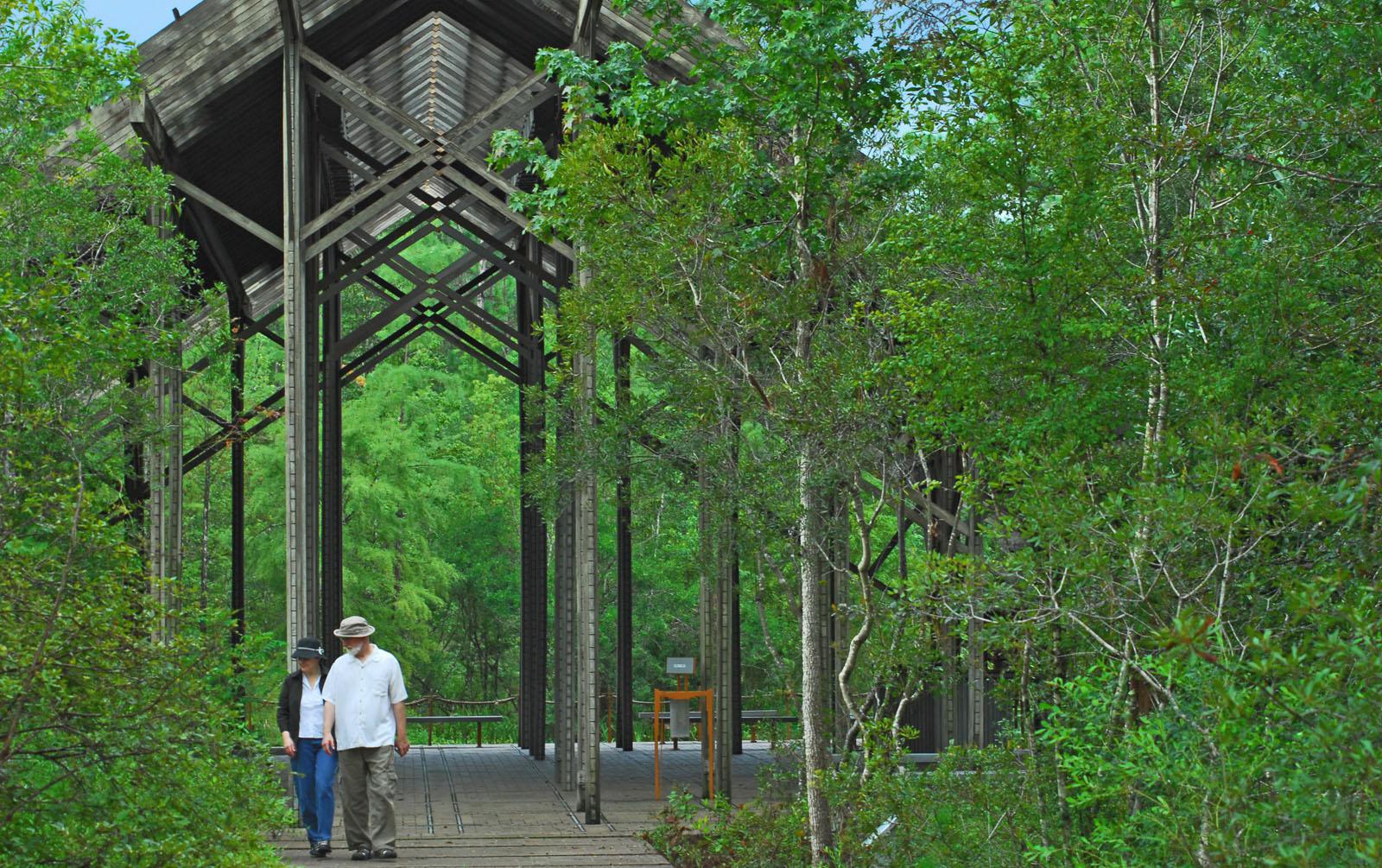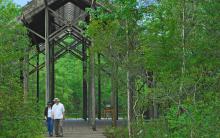Information Possibly Outdated
The information presented on this page was originally released on May 7, 2009. It may not be outdated, but please search our site for more current information. If you plan to quote or reference this information in a publication, please check with the Extension specialist or author before proceeding.
Crosby arboretum celebrates nature
By Karen Templeton
MSU Ag Communications
MISSISSIPPI STATE – What was once a Depression-era strawberry farm now provides protection to some of the Southeast’s most diverse but disappearing habitats.
The Crosby Arboretum, located in Picayune, was established in 1980 as a living memorial to timber pioneer and philanthropist L.O. Crosby Jr. It is part of Mississippi State University’s Coastal Research and Extension Center and provides protection to the native plant species of the Pearl River Drainage Basin of south-central Mississippi and Louisiana.
Visitors can view plants in their natural setting as they walk through the 104-acre native plant center. The arboretum also manages more than 700 acres in seven associated natural areas that protects 300 species of indigenous trees, shrubs, wildflowers and grasses.
“What sets the arboretum apart is that it was the first in the country to be designed after taking a holistic look at the regional environment,” said Bob Brzuszek, assistant professor in MSU’s Department of Landscape Architecture. “It wasn’t about bringing in plants from other regions. The focus was on protecting and nurturing what was already in the area.”
Ed Blake Jr., founding principal of The Landscape Studio in Hattiesburg, was a professor in MSU’s Department of Landscape Architecture in 1981 when he was asked to lead a team in designing the arboretum.
“The South is a one-of-a-kind place, and we wanted to highlight what sets us apart from the rest of the botanical world,” Blake said. “The founders asked us to seek a balance between science, arts and the humanities in our design. We also wanted to provide a deeper understanding of the human place in nature.”
To achieve this, Blake used the published work of historians and cultural geographers to generate ideas while botanists provided an inventory of the existing plants and their habitats.
“I wanted to understand what brought people to the piney woods of the region, how they changed the woods and how the woods changed them,” Blake said. “Then we developed a master plan capturing that relationship and Mr. Crosby’s love for the outdoors.”
Blake said the result was that the piney woods landscape itself became the real exhibit.
“The land and natural setting is the display; our work was in choreographing how visitors would move through the landscape so they could follow the story of the area,” Blake said. “Walking the pond journey, strolling the savanna and visiting the pitcher plant bogs – each experience builds on the previous experience so that people end up seeing the landscape in a synergistic, ‘bigger picture’ kind of way.”
Brzuszek, who was the first curator of the arboretum, said the need for sustainability was well understood when developing the original plans.
“The arboretum was ahead of the curve in the sustainability movement,” Brzuzsek said. “We aimed for maintaining a natural environment visitors could enjoy and then go home and translate in their own gardens.”
Blake said the sustainability ideas came about early on in the design process.
“We hear ‘green’ all the time now, but this concept was already a part of what we were doing right here in Mississippi,” Blake said. “The landscape isn’t meant to be just a backdrop and attractive scenery; we looked at it for what it really is – a green infrastructure that makes life possible.”
The natural landscape not only provides visitors with beautiful views, but it also protects rare and threatened plant and animal species and disappearing habitats. The arboretum is a biologically diverse, rich system of natural communities providing a safe haven for these species.
“There are certain insects and animals that depend on the plants at Crosby,” Brzuszek said. “The piney forests serve as much-needed habitat for the quickly declining gopher tortoises and black pine snakes.”
The arboretum’s piney forests are dominated by the longleaf pines, which depend on fire for their development. Prescribed burning as a maintenance technique was planned in the initial design of the arboretum to mimic the natural wildfires that allow the piney woods to take root and thrive. Development pressure and the suppression of fire have led to the decline of more than 95 percent of the longleaf pines’ former habitat.
The arboretum’s design also incorporated water to preserve the disappearing habitat of the once-abundant carnivorous pitcher plants native to the Southeast. The arboretum provides a portion of this plant’s remaining habitat, estimated at only 3 percent of its former range.
Brzuszek said keeping native plants at the arboretum helps maintain the biological richness of the state and provides protection from natural disasters.
“Hurricane Katrina caused some tree damage and loss, but it did not interrupt the integrity of the arboretum,” Brzuszek said. “Native plants have a genetic resilience to natural disasters that occur in their habitat. Plant species from other parts of the country would not have fared as well.”
Pat Drackett, senior arboretum curator, said visitors appreciate the original vision for the Crosby Arboretum that is still alive today. The arboretum staff invites the public to learn about the beauty of its natural environment and native plants through educational and outreach activities. Classes, workshops and recreational activities are offered to all ages on topics such as landscape design, nature photography, yoga and pine needle basket making. It also hosts two large annual events, Wildlife Day and the Heritage Festival.
“We have a variety of programs demonstrating how native plants can be incorporated into home landscapes,” Drackett said. “The educational and recreational activities we provide here apply to a broad spectrum of people, everyone from home gardeners and photographers to those interested in botany and entomology. We want them to appreciate our site and the native plants here in any way that appeals to them, whether it is butterfly gardening, nature sketching or taking a pleasant walk in the woods.”
Drackett said programs and events focus on helping visitors reflect on and interact with the natural surroundings.
“Mr. Crosby’s daughter, Lynn Crosby Gammill, reminds us that this place is to be a ‘celebration of nature.’ She is right, and I see that idea alive and well every day,” Drackett said.





